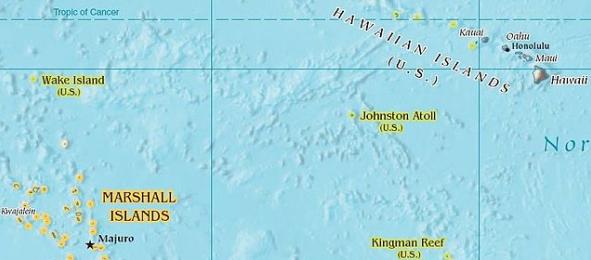
INTRODUCTION
On the 9th of July 1962 the USA exploded a nuclear (fusion) bomb at an altitude of 400 kilometres above Johnston Island (Atoll) in the Pacific. The device was lofted to the explosion point by a Thor missile launched from Johnston Island. It exploded at 9 seconds after 9 hours Univeral Time (09:00:09 UT), 13 minutes and 41 seconds after liftoff. The test detonation was codenamed "Starfish Prime". It was an exoatmospheric explosion as it took place well above the lower atmosphere, and even above the peak of the ionosphere in the upper atmosphere.

EFFECTS
The explosion was seen from Hawaii in the east to Kwajalein Island in the west and by a large number of US Navy ships and US Air Force aircraft deployed to monitor the event.
The explosion was about 1445 km from Honolulu and could be seen through clouds, as seen in the two images below:
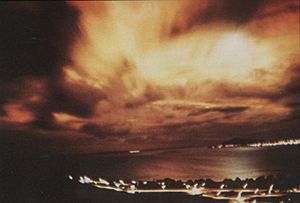 |
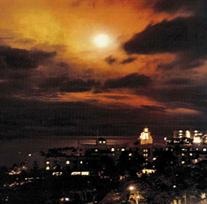 |
| A clear view of the explosion was obtained from one of the mountain observatories in Hawaii. Images of aurora created by the detonation were also obtained from high flying aircraft (image at right) and rockets launched in support of the exercise. |
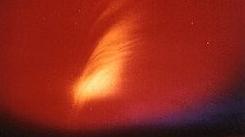
|
An electromagnetic pulse (EMP) created by the exoatmospheric blast was much larger than expected and damaged the electrical grid in Hawaii, shutting down about 300 street lights, setting off numerous buglar alarms. Damage was also caused to a microwave telephone link, isolating communications between some of the Hawaiian islands.
HIGH FREQUENCY COMMUNICATIONS
It was expected that HF communications would be affected over the Pacific and to that end a request to monitor such communication links was issued. One person who took up the challenge was a dedicated radio amateur in Hobart, Len Evans (VK7LE). He wrote up his results in a subsequent issue of the Wireless Institute of Australia journal "Amateur Radio".
Evans set up his equipment as shown below:
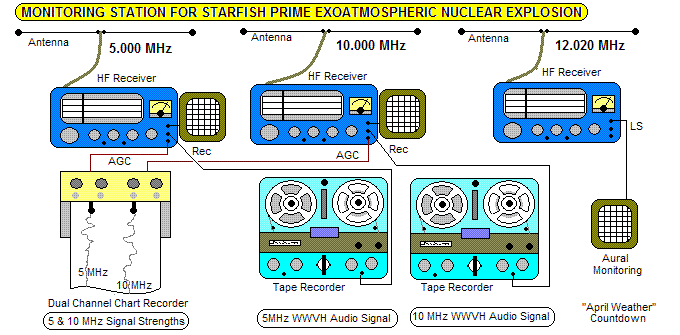
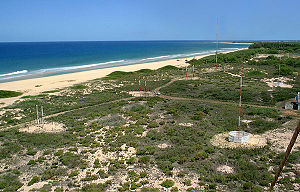 |
Two receivers were used to monitor the transmissions from the standard time and frequency station WWVH, transmitting from the Hawaiian island of Kauai, shown at left. This transmits on the
specially reserved frequencies of 2.5, 5, 10, 15, and 20 MHz. Only the 5 and 10 MHz frequencies were consistently received at Hobart and these were the two frequencies chosen for monitoring.
Unfortunately other standard time and frequency stations use these frequencies. These include WWV (Washington), JJY (Tokyo), BPV (China) and HBN in Switzerland. Fortunately, at Hobart, the WWVH signal was predominant, and could be readily identifed both aurally and by the carrier signal breaks at 15 minutes past the hour. |
A third receiver was used to monitor special military broadcasts of the countdown on a number of frequencies including 12020 and 15515 kHz. Using SSB modulation these stations transmitted status reports under the codename "April Weather".
A dual channel chart recorder was used to monitor the received signal strength on 5 and 10 MHz. Two tape recorders were used to record the audio signals from each receiver. These also allowed accurate sub-second timing of the events.
RESULTS
The graph Len Evans obtained from the chart recorder is shown below:
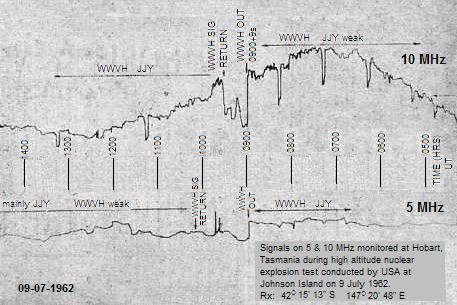
On the days prior to the explosion Evans determined that the 10 MHz WWVH signal was consistently present from 1400 to 0500 hours local time (0400-1900UT), and that the 5 MHz signals were consistently present from 1600 to 0400L (0600-1800UT).
Chart recordings were made for about six weeks prior to the detonation to establish a daily signal pattern to serve as a comparison reference.
On the day of the detonation, the signals disappeared abruptly at exactly 9 seconds past the 9th hour UT (1900L). Evans describes this as ".. the signal from WWVH on 10 MHz continued until the 9th second pulse and then also cut out completely with a sharp click". The tape recorders showed that the signals from both the WWVH transmitters disappeared completely.
"On 10 MHz the signal returned weakly approx 12 minutes later and then faded out again, gradual return to normal took place 32 minutes after the explosion, but faded again 16 minutes later. It appears from the chart that WWVH signals were only present at 1115 UT and 1315 UT with little other evidence of signal for the rest of the night. The signal on 5 MHz returned weakly approx 70 minutes after the event and remained very weak throughout the rest of the night."
DISCUSSION
The absorption of HF radio energy is due to the presence of ionisation in the D-region (about 70 to 90 km altitude). In the day time, ionisation is present due to both solar Lyman-alpha and solar soft X-rays. This essentially disappears at night. However, the explosion of a nuclear bomb at high altitude creates copious quantities of gamma-rays and these will create large amounts of ionisation in this region. When radio waves come upon the electrons that have been released from atoms in the ionisation process they are set vibrating. This vibration increases the probability that the electrons will collide with neutral atoms. When this occurs the radio energy is absorbed.
The map below shows the location of the WWVH transmitters, the monitoring station in Hobart, Johnston Atoll and the great circle path between transmitter and receiver that the HF signals would normally travel.
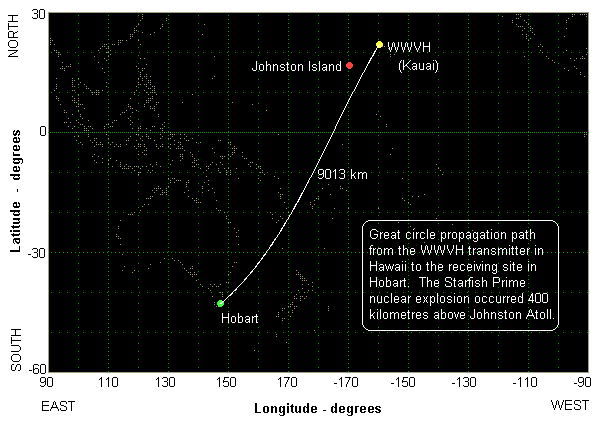
Evan's recordings showed that the signal cut out sharply in less than one second of the explosion initiation. This means that the D-region ionisation was also created in less than a second, even though the relevant portion of the ionosphere was a few hundred kilometers away from the explosion centre. Gamma rays travel at the speed of light in straight lines (until absorbed).
Widespread aurorae were observed across the western pacific. These tend to occur around the same D-region or a little higher in altitude. The free particles produced by the gamma radiation not only produce aurora close to the explosion site, but they also travel up and along the geomagnetic field lines to the conjugate point on the opposite side of the geomagnetic equator (in this case to the south) where they also produce aurora.
There are four main effects of an exoatmospheric burst such as that of Starfish Prime:
REFERENCES
Len Edwards (VK7LE), High Altitude Nuclear Explosion at Johnston Island and Associated Effects on HF Signals at Hobart, Tasmania, Amateur Radio, 31(#4), pp7, 19 (April 1963)
 Australian Space Academy
Australian Space Academy